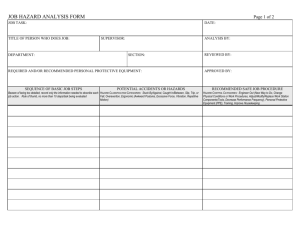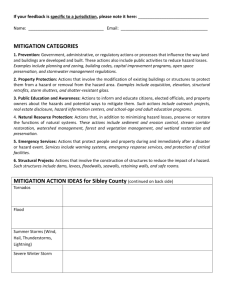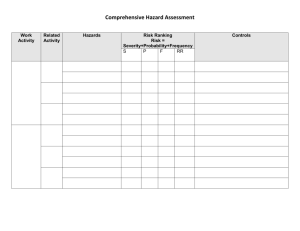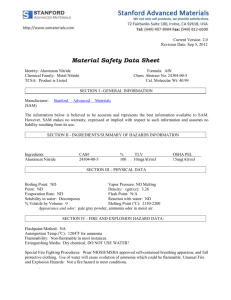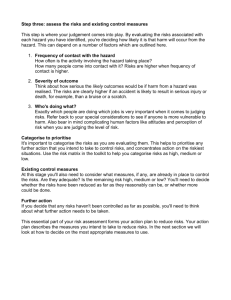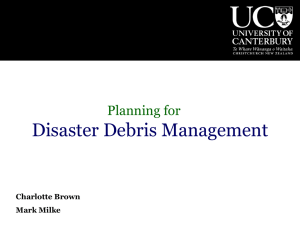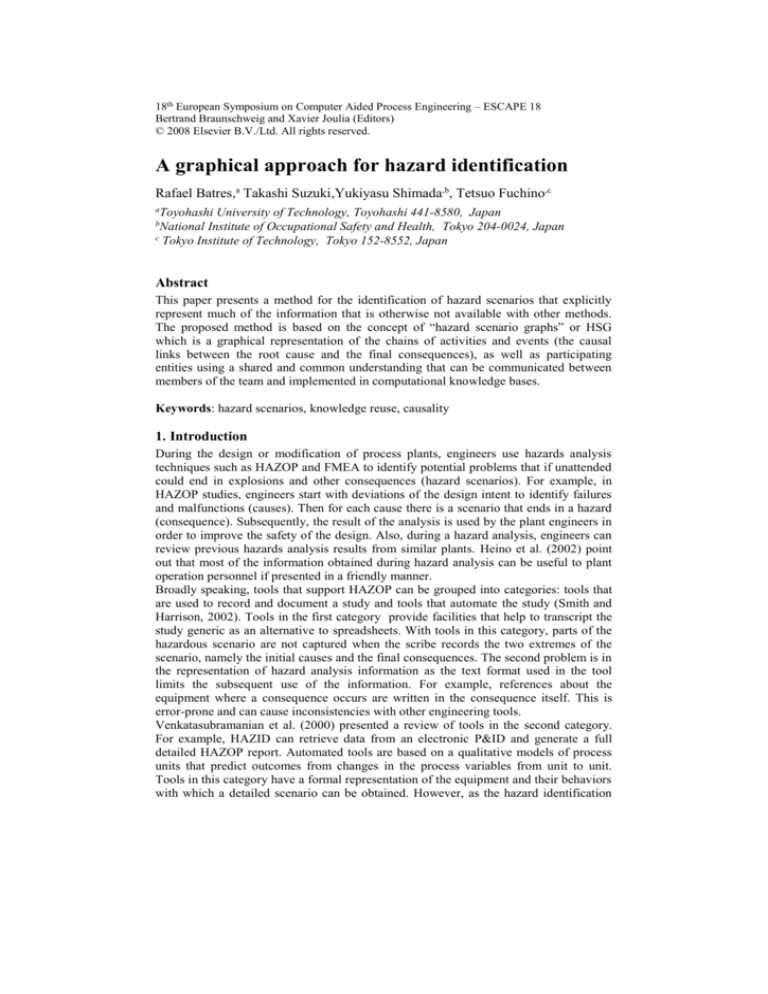
18th European Symposium on Computer Aided Process Engineering – ESCAPE 18
Bertrand Braunschweig and Xavier Joulia (Editors)
© 2008 Elsevier B.V./Ltd. All rights reserved.
A graphical approach for hazard identification
Rafael Batres,a Takashi Suzuki,Yukiyasu Shimada,b, Tetsuo Fuchino,c
a
Toyohashi University of Technology, Toyohashi 441-8580, Japan
National Institute of Occupational Safety and Health, Tokyo 204-0024, Japan
c
Tokyo Institute of Technology, Tokyo 152-8552, Japan
b
Abstract
This paper presents a method for the identification of hazard scenarios that explicitly
represent much of the information that is otherwise not available with other methods.
The proposed method is based on the concept of “hazard scenario graphs” or HSG
which is a graphical representation of the chains of activities and events (the causal
links between the root cause and the final consequences), as well as participating
entities using a shared and common understanding that can be communicated between
members of the team and implemented in computational knowledge bases.
Keywords: hazard scenarios, knowledge reuse, causality
1. Introduction
During the design or modification of process plants, engineers use hazards analysis
techniques such as HAZOP and FMEA to identify potential problems that if unattended
could end in explosions and other consequences (hazard scenarios). For example, in
HAZOP studies, engineers start with deviations of the design intent to identify failures
and malfunctions (causes). Then for each cause there is a scenario that ends in a hazard
(consequence). Subsequently, the result of the analysis is used by the plant engineers in
order to improve the safety of the design. Also, during a hazard analysis, engineers can
review previous hazards analysis results from similar plants. Heino et al. (2002) point
out that most of the information obtained during hazard analysis can be useful to plant
operation personnel if presented in a friendly manner.
Broadly speaking, tools that support HAZOP can be grouped into categories: tools that
are used to record and document a study and tools that automate the study (Smith and
Harrison, 2002). Tools in the first category provide facilities that help to transcript the
study generic as an alternative to spreadsheets. With tools in this category, parts of the
hazardous scenario are not captured when the scribe records the two extremes of the
scenario, namely the initial causes and the final consequences. The second problem is in
the representation of hazard analysis information as the text format used in the tool
limits the subsequent use of the information. For example, references about the
equipment where a consequence occurs are written in the consequence itself. This is
error-prone and can cause inconsistencies with other engineering tools.
Venkatasubramanian et al. (2000) presented a review of tools in the second category.
For example, HAZID can retrieve data from an electronic P&ID and generate a full
detailed HAZOP report. Automated tools are based on a qualitative models of process
units that predict outcomes from changes in the process variables from unit to unit.
Tools in this category have a formal representation of the equipment and their behaviors
with which a detailed scenario can be obtained. However, as the hazard identification
2
R. Batres et al.
method is predefined, users cannot use the tools for other methods such as FMEA or
user-defined hazard identification methods.
The approach presented in this paper is an alternative approach to HAZOP and FMEA
and can be integrated with any of those tools.
This paper presents a method for the identification of hazard scenarios that explicitly
represent much of the information that is otherwise not available with other methods.
The proposed method is based on the concept of “hazard scenario graphs” or HSG
which is a graphical representation of the chains of activities and events (the causal
links between the root cause and the final consequences), as well as participating
entities using a shared and common understanding that can be communicated between
members of the team and implemented in computational knowledge bases. HSG is
based on ontologies and knowledge representation techniques with which knowledge
extraction is possible. The method explicitly represents causality, substances,
equipment, physical and chemical transformations, plant operations and personnel,
facilitating the integration with other engineering tools such as CAD systems. In
addition, a support system was developed to assist engineers in developing and using
HSGs. Graph editing and knowledge extraction facilities were developed using
knowledge engineering tools (JTP inference engines) and a the JGo graphic package.
Firstly, the hazard scenario graphs are introduced. Then the methodology is explained.
Finally, the proposed method is illustrated with the hazard analysis of a DAP
(Diammonium Phosphate) production process.
2. Hazard Scenario Graphs
Hazard scenario graphs (HSGs) are visual representations of the sequences or networks
of events and activities in a hazard scenario. HSGs are based on concepts defined in the
ISO 15926 standard that specifies an ontology for the representation of knowledge
about process plants (Batres, 2007). ISO 15926 Part 2 (standardized as ISO 159262:2003) specifies a “lingua franca” for long-term data integration, access and exchange.
It was developed in ISO TC184/SC4-Industrial Data by the EPISTLE consortium
(1993-2003) and designed to support the evolution of data through time. The standard
includes the definition of kinds and structures of objects, properties, events, processes
and relations which can be used in the integration of material property data, equipment
information, maintenance activities, etc. Furthermore, not only does ISO 15926 record
the process plant as it exists at an instant but also it does record how the plant changes
as a result of normal (e.g. maintenance) or abnormal activities. This is critical during the
analysis of contributing causes.
A hazard scenario graph is composed of the following elements from the ISO 15926
standard:
1. Activities. An activity is a possible individual that brings about change by causing an
event. Classes of activities include physicochemical processes, plant operations, and
abnormal situations. Examples of activity are “Level increasing” and “Closing feed
valve”.
2. Events. An event is a possible individual that has zero extent in time, which means
that it occurs at an instant in time. Events are shown by ovals. A point in time such as
‘UTC 1999-05-13T16:31:23.56’ is a kind of event.
3. Physical objects. A physical object is a distribution of matter, energy, or both.
Examples of physical object are a tank, pump, a stream of material, a person.
A graphical approach for hazard identification
4. Participating entities are enclosed by hexagons
5. Causal relations are represented as solid arrows identified by the word “cause of
event”. A “cause of event” relation connects an activity with one or more events.
6. Temporal relations (beginning and ending) are represented as solid line with a filled
circle identified by either the words “beginning” or “ending”. A temporal relation
connects an activity with an event. Physical objects are temporally bounded. For
example, the physical object “pump P-01 during normal operation” has a begins when
the pump was switched on and ends when a cavitation occurred.
7. The participation relation is represented as a solid line with an empty circle identified
by the word “participation”
Causal relations are represented by the cause of event relations. A cause of event
indicates that the caused (event) is caused by the causer (activity). Temporal binding
relationships are represented by beginning and ending relations. A beginning relation
marks the temporal start of an activity or physical objects. An ending relation marks the
end of a possible individual. A participation relation is a part-whole relation that
indicates that physical objects are resources, instruments, or performers of an activity.
Causality in HSG follows the properties described by Shoham (1988) some of which are
listed here:
1. Causality is antisymmetric. A cannot cause B if B is the cause of A
2. Causality is antireflexive. A cannot cause itself.
3. Causes cannot succeed their effects in time. A(s) causes A(t) s t
4. Entities participating in the causal relation have a temporal dimension. For example,
explosions, runaway reactions, mixing operations, all have a beginning and an ending.
Similarly, a reactor during a runaway reaction has also a beginning and an end. This
participating entities are possible individuals in terms of the ISO 15926 standard.
5. Domotor adds the property of transivity (Findler, 1996):
If A causes B and B is the cause of C, then A is also the cause of C. Using the HSG
relations this is formalized as follows: a1, a2 activity; e1, e2 event
[ (cause_of_ event a1 e1 ) (beginning e1 a2 ) (cause_of_ event a2 e2 ) ] (cause_of_ event a1 e2 )
3. Methodology
Step 1. Define the system boundary. This step is also carried out in HAZOP and its
purpose is to specify the parts of the system (plant, recipe, operating procedure, control
system, etc.) that are to be analyzed.
Step 2. For each piece of equipment and pipelines in the system boundary identify
abnormal activities. Abnormal activities include possible equipment malfunctions,
undesired physicochemical phenomena, abnormal operations, external events (impacts,
earthquakes). This can be done using FMEA’s fault modes or HAZOP deviations.
Step 3. Identify possible propagation scenarios based on the topology of the plant for
each of the abnormal activities. An activity causes an event that is the beginning of
another activity.
4. Identify activities and events derived from those found in step 3.
5. For each of the activities or events in step 4, identify the hazards that may result.
6. Rank the scenarios in terms of risk and severity of the hazards
7. Go back to step 3 to continue with the rest of the abnormal activities
8. Go back to step 2 to continue with the rest of the equipment items.
3
4
R. Batres et al.
During the construction of the scenario mereological relations can be used to indicate
that activities or events occur during the time boundaries of another activity. For
example, an “abnormal” no-flow situation in a pipe can only occur when material is
flowing in that pipe.
4. Example
The following example is from the CCPS book series (CCPS, 1992). This is a process in
which ammonia and phosphoric acid react to form diammonium phosphate (DAP), a
nonhazardous product. The DAP flows from the reactor to an open-top storage tank.
Low ratios of phosphoric acid/ammonia result in an off-specification product, but the
reaction is safe. If both amounts of ammonia and phosphoric acid increase, the rate of
energy release may accelerate, resulting in increase in temperature and pressure and
reactor failure. If too much ammonia is fed to the reactor, unreacted ammonia may flow
into the DAP storage tank, causing ammonia release and consequently personnel
exposure.
RV-2
RV-1
ammonia
unloading
stations
T-101
RV-3
LI
I-10
P-26
FI
I-7
T-102
LI
I-9
FI
I-8
Phosphoric
acid unloading
stations
P-21
CV-A
CV-B
R-1
Enclosed
Work
Area
V-C
V-D
DAP storage tank
To product loading
stations
Figure 1. Schematic diagram of the DAP example
Step 1. The system boundaries are the same as the limits of the schematic diagram
shown in Figure 1.
Step 2. The next step is to identify the abnormal activities for each of the equipment
items. For the ammonia storage tank, the abnormal activities are as follows: equipment
malfunctions include gasket and packing failures, no flow of ammonia in and out the
tank; undesired physicochemical phenomena include corrosion, erosion, level above the
safety limits, level above the safety limits; abnormal operations include inadequate
maintenance. External events include external impacts.
Step 3. For this example, the scenarios resulting from corrosion are investigated.
The resulting HSG is shown in Figure 2. Among other things, engineers can search not
only in one scenario but in a group of scenarios, which done with the use of inference
A graphical approach for hazard identification
relative_location
corrosion in T-01
5
cause_of_event
contamination starts
beginning
cause_of_event
hole in T-01
product contamination
beginning
T-01
relative_location
cause_of_event
product quality affected
T-01 leaks
cause_of_event
cause_of_event
Level in T-01 starts decreasing
ammonia release starts
beginning
relative_location
relative_location
Level in T-01 decreases
cause_of_event
T-01
concentration of ammonia starts decreasing
beginning
R-01
relative_location
Concentration of ammonia decreases
cause_of_event
loss of DAP production
Figure 2. A HSG of the DAP process
algorithms. For example, if we are interested in finding the causes of ammonia release,
the computer environment will dynamically integrate several scenarios to create a new
scenario that is specific to the causality of ammonia release. This is done using the
causality properties described in Section 2. Comparatively, a HAZOP study such as
shown in CCPS (1992) would assumed leak as a deviation of storage intent, find the
cause as corrosion and conclude that the possible consequence is loss of DAP
production. Consequently, the steps in between are omitted in the HAZOP report.
5. HSG Editor
The HSG editor is a Java application that allows the construction of HSGs and
intelligent queries to retrieve or combine parts of the information. HSGs are created by
connecting activities, events, and physical objects that are placed in the editing window
in a drag-and-drop fashion. The resulting HSG is internally represented in terms of the
ontology concepts and encoded in the OWL language. This enables the knowledge
extraction by the inference engine and the integration with other tools.
The editor was developed using the JGo, and Jena libraries. JGo is a Java component for
developing graph-related applications and Jena is used to generate OWL objects that are
passed to the inference for causality reasoning.
The inference engine (JTP) is an object oriented Modular Reasoning System developed
by the Knowledge Systems Laboratory of Computer Science Department in Stanford
University (Fikes et al., 2003). By default, JTP is composed of a number of reasoners
that implement algorithms such as generalized modus ponens, backward-chaining, and
forward chaining and unification. The results of the inference can be shown graphically.
For example, Figure 3 shows in red the relations connecting the causes of ammonia
release.
6. Conclusions
This paper presented a method that aims at a more efficient use of the hazard analysis
knowledge. Specifically, the Hazard Scenario Graph was discussed as a means to
describe the causality of the scenario and participating entities a compared to a segment
6
R. Batres et al.
of a HAZOP report. The construction of HSGs is possible by means of tools such as the
HSG Editor that allows the user to describe the scenario using drag-and-drop icons
augmented with semantic descriptions of causality and participating entities. The user
can then discover causal links derived from an activity, event or participating entity
selected by the user. Comments gathered from two recognized safety experts tell that
the hazard scenario graphs are easy to understand, the distinction between the different
elements of the graph allows a clear description of the causation, temporal information,
and the substances, equipment, personnel involved. Also because the hazard scenario
graph is based on ISO 15926, instances in the graph can be integrated with plant
databases such as those containing equipment data. An ontology of activities has been
developed and we are planning to integrate it with the editor.
Figure 3. A screendump of the HSG editor.
Acknowledgements. The authors are grateful to Mr. Toshinori Kawabata for the
evaluation of the HSG representation.
References
R. Batres, M. West, D. Leal, D. Price, M. Katsube, Y. Shimada, T. Fuchino. An upper ontology
based on ISO 15926. Comp. & Chem. Eng., 31, 5-6 (2007) 519–534
CCPS, Guidelines for Hazard Evaluation Procedures, with Worked Examples, AIChE 1992
R. Fikes, J. Jenkins, and F. Gleb, JTP: A System Architecture and Component Library for Hybrid
Reasoning. Proceedings of the SeventhWorld Multiconference on Systemics, Cybernetics, and
Informatics. Orlando, Florida, USA, July 27–30 (2003)
N. V. Findler, and T. Bickmore, Applied Artificial Intelligence 10 (1996) 455–487
P. Heino, P. Valkokari, K. Rönkkö, E. Kotikunnas and S. Lamberg, Operator Support for
Abnormal Situations using Safety and Reliability Knowledge, 15th Triennial World Congress
(2002)
Y. Shoham, Reasoning about Change, MIT Press, Cambridge, Massachusetts (1988)
S. P. Smith and M. D. Harrison, Supporting Reuse in Hazard Analysis, DIRC Workshop, London
(2002)
V. Venkatasubramanian, J. Zho, and S. Viswanathan, Intelligent Systems for HAZOP Analysis of
Complex Process Plants, Comp. & Chem. Eng., 24 (2002) 2291–2302

